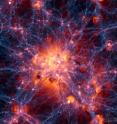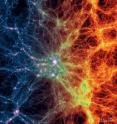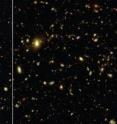Astronomers create first realistic virtual universe
Related images
(click to enlarge)
Move over, Matrix -- astronomers have done you one better. They have created the first realistic virtual universe using a computer simulation called "Illustris." Illustris can recreate 13 billion years of cosmic evolution in a cube 350 million light-years on a side with unprecedented resolution. "Until now, no single simulation was able to reproduce the universe on both large and small scales simultaneously," says lead author Mark Vogelsberger (MIT/Harvard-Smithsonian Center for Astrophysics), who conducted the work in collaboration with researchers at several institutions, including the Heidelberg Institute for Theoretical Studies in Germany.
These results are being reported in the May 8th issue of the journal Nature.
Previous attempts to simulate the universe were hampered by lack of computing power and the complexities of the underlying physics. As a result those programs either were limited in resolution, or forced to focus on a small portion of the universe. Earlier simulations also had trouble modeling complex feedback from star formation, supernova explosions, and supermassive black holes.
Illustris employs a sophisticated computer program to recreate the evolution of the universe in high fidelity. It includes both normal matter and dark matter using 12 billion 3-D "pixels," or resolution elements.
The team dedicated five years to developing the Illustris program. The actual calculations took 3 months of "run time," using a total of 8,000 CPUs running in parallel. If they had used an average desktop computer, the calculations would have taken more than 2,000 years to complete.
The computer simulation began a mere 12 million years after the Big Bang. When it reached the present day, astronomers counted more than 41,000 galaxies in the cube of simulated space. Importantly, Illustris yielded a realistic mix of spiral galaxies like the Milky Way and football-shaped elliptical galaxies. It also recreated large-scale structures like galaxy clusters and the bubbles and voids of the cosmic web. On the small scale, it accurately recreated the chemistries of individual galaxies.
Since light travels at a fixed speed, the farther away astronomers look, the farther back in time they can see. A galaxy one billion light-years away is seen as it was a billion years ago. Telescopes like Hubble can give us views of the early universe by looking to greater distances. However, astronomers can't use Hubble to follow the evolution of a single galaxy over time.
"Illustris is like a time machine. We can go forward and backward in time. We can pause the simulation and zoom into a single galaxy or galaxy cluster to see what's really going on," says co-author Shy Genel of the CfA.
Source: Harvard-Smithsonian Center for Astrophysics
Other sources
- Best of Last Week – Pondering future of inflation theory, an enclosed tube maglev and arguing about contacting aliensfrom PhysorgMon, 12 May 2014, 13:01:40 UTC
- Astronomers create first realistic virtual universefrom Harvard ScienceSat, 10 May 2014, 3:20:19 UTC
- Out of This World! Virtual Universe Looks Like the Real Thingfrom MSNBC: ScienceWed, 7 May 2014, 23:40:53 UTC
- Astronomers create first realistic virtual universefrom Science DailyWed, 7 May 2014, 23:20:12 UTC
- Universe's evolution mapped in unprecedented detailfrom CBC: Technology & ScienceWed, 7 May 2014, 20:20:19 UTC
- Universe re-created in computer simulationfrom Sciencenews.orgWed, 7 May 2014, 19:30:49 UTC
- Astronomers create first realistic virtual universefrom PhysorgWed, 7 May 2014, 18:01:28 UTC
- Evolution of the Universe Revealed by Computer Simulation (Gallery)from Space.comWed, 7 May 2014, 17:31:56 UTC
- New Simulation Re-Spins the Cosmic Web More Accurately | Videofrom Space.comWed, 7 May 2014, 17:31:50 UTC
- Amazing Time-Lapse Video Shows Evolution of Universe Like Never Before (Video, Images)from Space.comWed, 7 May 2014, 17:31:44 UTC
- Universe evolution recreated in labfrom BBC News: Science & NatureWed, 7 May 2014, 17:30:35 UTC
- Astrophysicists Build a Virtual Universefrom Science NOWWed, 7 May 2014, 17:20:15 UTC
- New Universe Evolution Simulation Most Accurate Yet | Videofrom Space.comWed, 7 May 2014, 17:01:07 UTC
- New Simulations Explore Supernova Explosions and Universe Evolution (Video)from Space.comTue, 6 May 2014, 11:40:42 UTC


